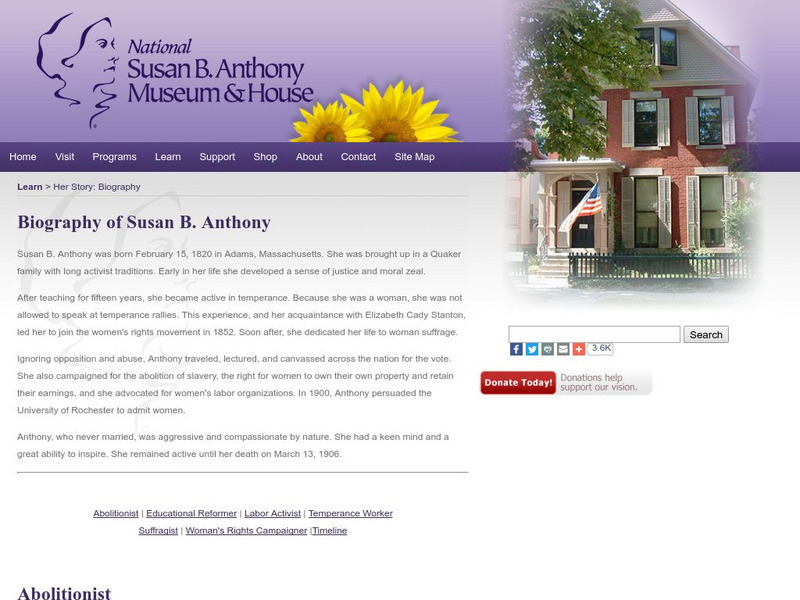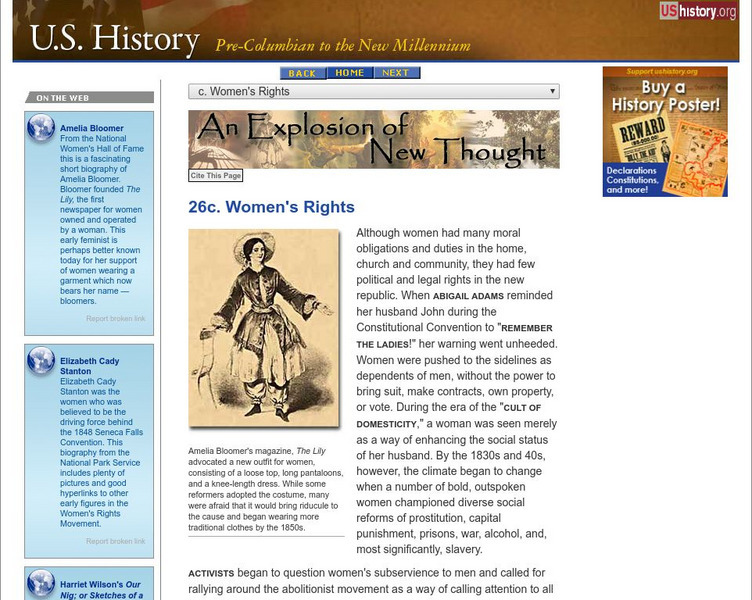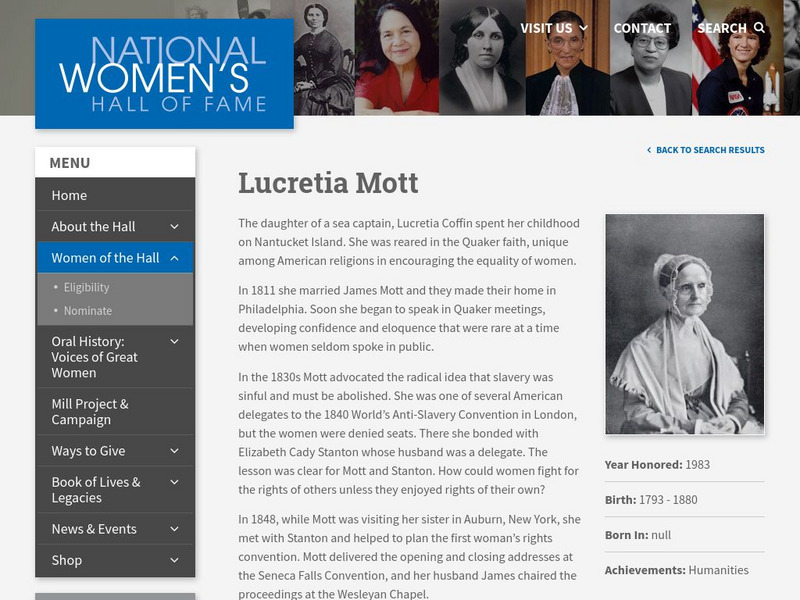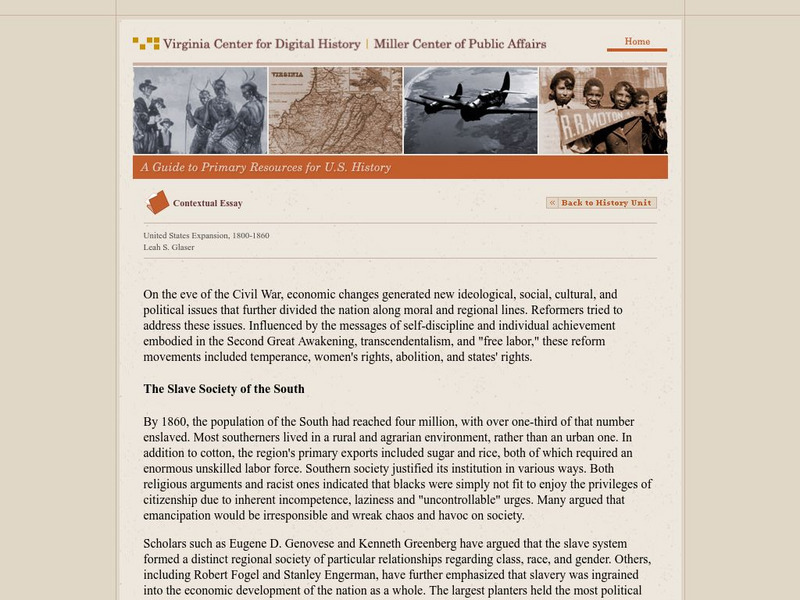Hi, what do you want to do?
Curated OER
Working on the Railroad
Students view and discuss "The Transportation Revolution," a lecture by Peter A. Coclanis. They read and respond creatively to brief descriptions of railroad workers and their job responsibilities.
Curated OER
Criminal or Hero
Fifth graders explore the origins of slavery. In this US History instructional activity, 5th graders create a map of the United States that shows where slavery existed. Students examine the life of a Northern slave through...
Curated OER
Knowledge is Power
Students explore the distinct forms of knowledge that enslaved Africans brought with them to America or developed while enslaved. They study how political movements of the 18th century helped develop abolitionist thinking.
Curated OER
Before Rosa Parks: Upper Grades Activity: Frances Watkins Harper
Students analyze the rhetorical strategies Frances Watkins Harper used, such as tone, emotional appeal and descriptive language
Curated OER
War Time Propaganda: American Posters of the Great War
Students identify propaganda related to World War and discuss its impact on society and research issues related to the American war effort between 1914 and 1918.
Curated OER
Reform Movements (5)
For this online interactive American history worksheet, students answer 20 matching questions regarding reform movements. Students may submit their answers to be scored.
National Women’s History Museum
National Women's History Museum: Sarah Moore Grimke
Learn about Sarah Grimke who with her sister fought for abolition and women's rights.
National Women’s History Museum
National Women's History Museum: Sojourner Truth
A former slave, Sojourner Truth was an advocate for abolition, temperance, and civil and women's rights in the 19th century.
Social Studies for Kids
Social Studies for Kids: Sojourner Truth: Voice for Abolition and Women
Born into slavery and never able to read or write, Sojourner Truth nonetheless was a tired and famous advocate for both abolition and women's voting rights.
Smithsonian Institution
Smithsonian Learning Lab: Powerful Symbols and Words: Abolitionism & Women's Rights
This collection looks at an image and phrase used widely in abolitionist materials, and at how that symbol was adopted and adapted by Sojourner Truth and/or other women's rights activists. Students will examine an abolitionist medallion...
National Women’s History Museum
National Women's History Museum: Sojourner Truth
Learn more about Sojourner Truth, the outspoken advocate for abolition, temperance, and civil and women's rights.
Curated OER
National Park Service: Women's Rights: How Five Women Changed the World
This site introduces the Women's Rights National Historical Park. Touches on information about the Seneca Falls Convention and the signing of the Declaration of Sentiments. Hyperlinks lead to additional information.
OpenStax
Open Stax: Women's Rights
From a chapter on " Antebellum Idealism and Reform Impulses," this section explains the connections between abolition, reform, and antebellum feminism and also describes the ways antebellum women's movements were both traditional and...
Other
University of Michigan: Susan B. Anthony House: Susan B. Anthony
This resource divides her life into the following parts: abolitionist, educational reformer, labor activist, temperance worker, suffragist, and women's rights campaigner.
Texas State Library and Archives Commission
Texas State Library and Archives Commission: Beginnings of the Movement: Abolition and Early Women's Rights Movement
How was the anti-slavery movement tightly connected with women's right to vote? Explore the efforts of women abolitionists, who realized that "the injustice they wanted to remedy for blacks also applied to women." Primary texts at this...
Independence Hall Association
U.s. History: Women's Rights
Read about some outspoken women in the 1830s and 1840s, who began speaking out for reforms of many kinds, particularly on the issue of slavery and the rights of women to vote. The Seneca Falls Declaration pushed this idea of equality.
PBS
Pbs: Angelina and Sarah Grimke
A biography of the Grimke sisters, women who were before their time in so many ways and who fought for equality of the sexes.
University of Virginia
Uncle Tom's Cabin and American Culture: The Woman's Rights Movement
Read about the 19th century women's reform movement as well as primary resources including the Seneca Falls Declaration & Resolutions, an editorial by Frederick Douglass, and excerpts form "History of Woman Suffrage."
National Women's Hall of Fame
National Women's Hall of Fame: Lucretia Mott
The National Women's Hall of Fame offers a brief biography on the life of Quaker abolitionist and women's rights advocate, Lucretia Mott.
University of Virginia
Virginia Center for Digital History: United States Expansion, 1800 1860
An essay that looks at issues affecting Americans leading up to the Civil War. These included economic changes that led to new ideological, social, cultural, and political issues that further divided the nation along moral and regional...
Texas State Library and Archives Commission
Texas State Library and Archives Commission: Beginnings of the Movement: The Second Great Awakening
What did the Second Great Awakening have to do with women's rights and social reform? How was it a stepping stone for the women's suffrage movement? Find out how this movement, which emphasized individual worth, empowered women...
National Women's Hall of Fame
National Women's Hall of Fame: Sara Grimke
Read about the life and accomplishments of abolitionists Angelina Grimke and Sarah Grimke, important political figures in the anti-slavery movement.
Texas State Library and Archives Commission
Texas State Library and Archives Commission: Texas Joins the Battle: Lucy Stone to Mariana Folsom, January 22, 1885
Read a brief biography of Lucy Stone, "one of the pioneers of the women's suffrage movement," and also read a letter she wrote to Mariana Folsom, another suffragist. Image of actual letter is accompanied by line-by-line transcription.
Wikimedia
Wikipedia: Harriet Tubman
This article overviews Harriet Tubman's involvement with the Underground Railroad, her service in the military during the Civil War, and her fight as an activist for African-American and women's rights.

























